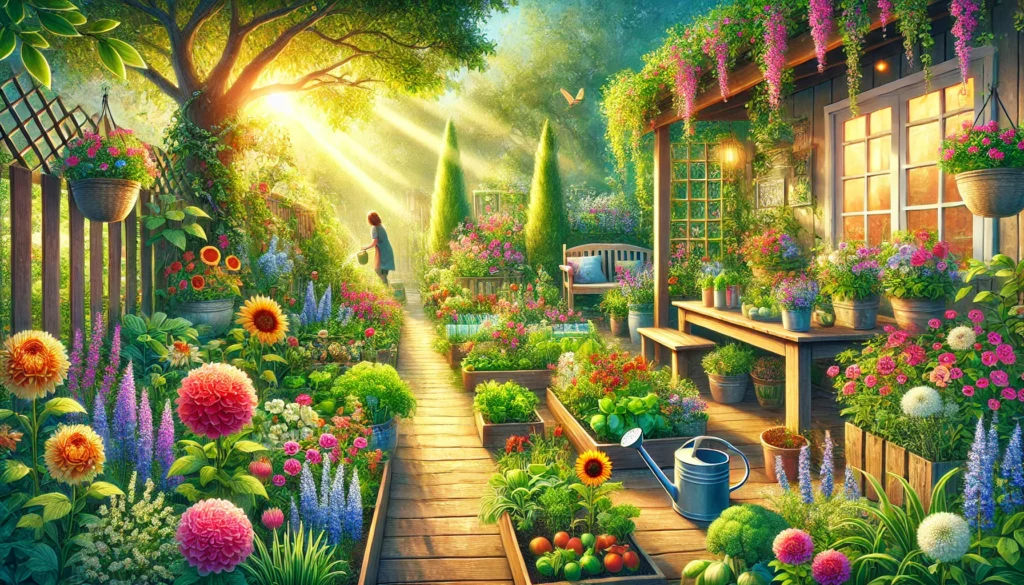Introduction: The Joy of Home Gardening
Home gardening is more than just a hobby—it’s a sustainable lifestyle choice that brings nature closer to your living space. Whether you have a sprawling backyard, a small balcony, or just a sunny windowsill, growing plants at home enhances air quality, reduces stress, and provides fresh, organic produce. This comprehensive guide covers everything from selecting the right plants to nurturing them for optimal growth.

1. Choosing the Right Plants for Your Home Garden
The first step in home gardening is selecting plants that suit your space, climate, and level of commitment.
A. Best Plants for Beginners
- Herbs – Easy to grow in small pots:
- Basil, Mint, Coriander, Parsley, Thyme
- Care: Requires 4-6 hours of sunlight, well-drained soil, and regular watering.
- Leafy Greens – Fast-growing and nutritious:
- Spinach, Lettuce, Kale, Fenugreek (Methi)
- Care: Partial sunlight, moist soil, and frequent harvesting.
- Flowering Plants – Adds beauty and attracts pollinators:
- Marigold, Petunia, Sunflower, Hibiscus
- Care: Full sunlight, moderate watering, and occasional pruning.
B. Best Plants for Small Spaces (Balcony/Indoor Gardening)
- Succulents & Cacti – Low-maintenance and drought-resistant.
- Microgreens – Fast-growing (ready in 1-2 weeks) and nutrient-packed.
- Dwarf Fruit Plants – Tomatoes, Chillies, Lemons (can grow in pots).
C. Best Plants for Large Gardens (Vegetables & Fruits)
- Tomatoes, Brinjal (Eggplant), Okra (Bhindi), Cucumber
- Fruit Trees – Mango, Guava, Pomegranate (requires space and sunlight).
2. Essential Gardening Supplies
Before starting, gather these basic tools:
✔ Soil – Use well-draining potting mix for containers; compost-enriched soil for gardens.
✔ Pots/Containers – Terracotta pots, grow bags, or recycled containers with drainage holes.
✔ Watering Can/Spray Bottle – For gentle watering.
✔ Fertilizers – Organic options like cow manure, vermicompost, or seaweed extract.
✔ Pruning Shears & Gloves – For trimming and protection.
3. Step-by-Step Guide to Planting
A. Preparing the Soil
- Mix garden soil with compost (30%) and sand (10%) for better drainage.
- For potted plants, use a ready-made potting mix.
B. Sowing Seeds or Transplanting Saplings
- Seeds: Plant at twice their depth (check packet instructions).
- Saplings: Gently transfer from nursery pots, ensuring roots are intact.
C. Watering Techniques
- Morning is best (reduces evaporation and fungal growth).
- Avoid overwatering – Check soil moisture with your finger.
D. Sunlight Requirements
- Full Sun (6+ hours) – Most vegetables & flowering plants.
- Partial Shade (3-6 hours) – Leafy greens, herbs.
- Low Light (Indoors) – Snake plant, ZZ plant, Pothos.
4. Caring for Your Home Garden
A. Fertilizing
- Every 2-3 weeks for vegetables/flowering plants.
- Use organic fertilizers like banana peel tea, eggshell powder, or compost.
B. Pest Control (Natural Remedies)
- Neem Oil Spray – Effective against aphids and mites.
- Garlic-Chili Spray – Deters insects naturally.
- Ladybugs & Earthworms – Beneficial for soil health.
C. Pruning & Harvesting
- Trim dead leaves to encourage new growth.
- Harvest leafy greens regularly to promote bushier growth.
5. Seasonal Gardening Tips
- Summer: Grow okra, cucumber, gourds; water deeply.
- Monsoon: Ideal for mint, coriander, ferns; avoid waterlogging.
- Winter: Best for carrots, spinach, radish, broccoli.
6. Benefits of Home Gardening
✔ Fresh, Organic Produce – Free from pesticides.
✔ Mental Well-being – Reduces stress and anxiety.
✔ Eco-Friendly – Reduces carbon footprint.
✔ Educational for Kids – Teaches responsibility and nature appreciation.
Conclusion: Start Small, Grow Big!
Home gardening is a rewarding journey that connects you with nature. Whether you grow herbs on a windowsill or vegetables in a backyard, every plant adds life to your home. Begin with easy-to-grow plants, follow proper care techniques, and watch your green space thrive.
🌱 Pro Tip: Keep a gardening journal to track growth and learn from experience!
Happy Gardening! 🌿🌻
FAQ
Q: Can I grow plants without sunlight?
A: Yes! Low-light plants like snake plants, pothos, and peace lilies thrive indoors.
Q: How often should I water my plants?
A: Depends on the plant—check soil moisture before watering.
Q: What’s the easiest vegetable to grow?
A: Spinach, tomatoes, and green chilies are great for beginners.
Would you like a personalized plant recommendation based on your space? Let me know! 😊
